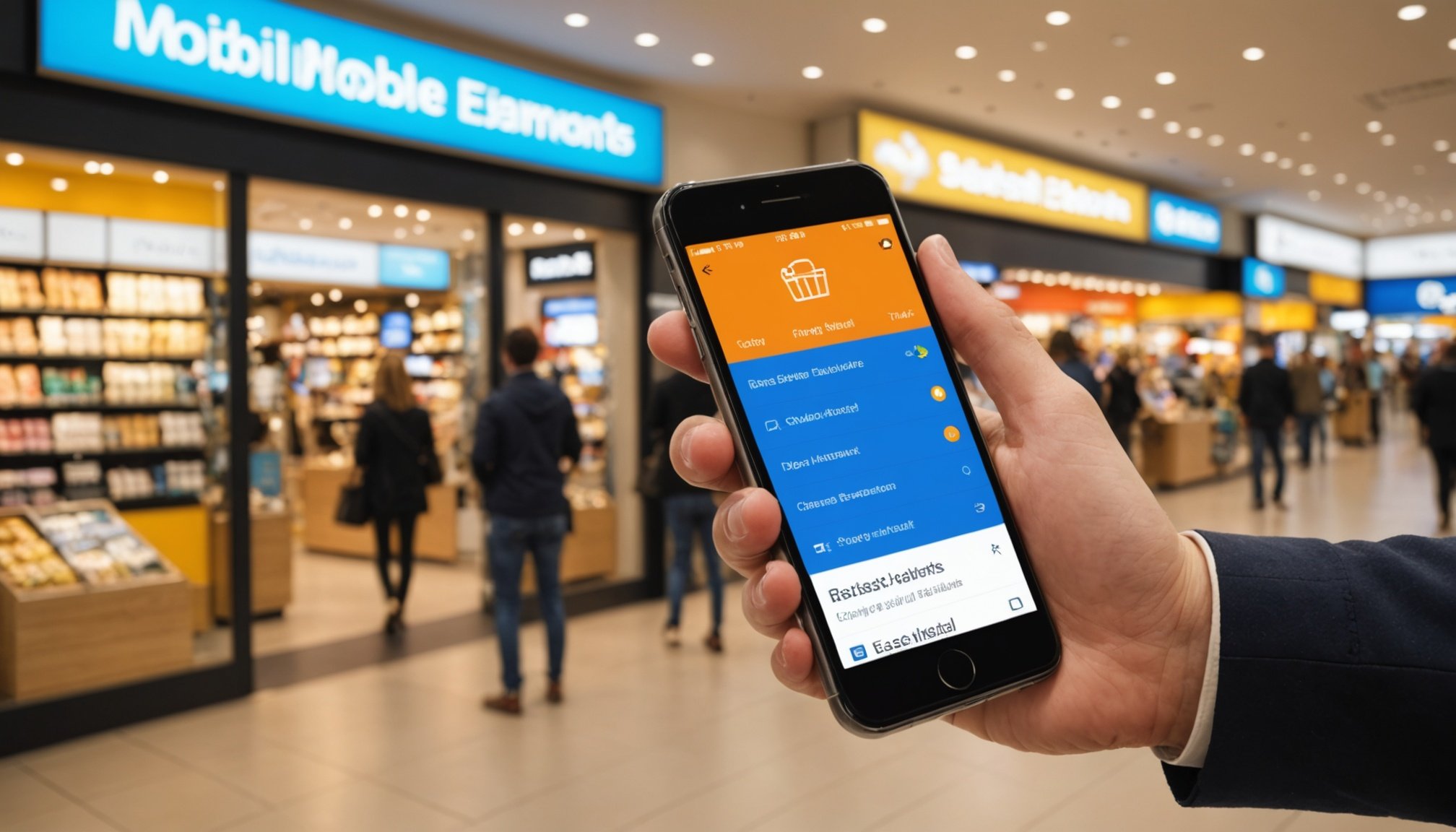Introduction to Tailored Mobile Applications for Retail
In today’s retail sector, mobile applications are proving indispensable, acting as a bridge between businesses and consumers. The UK market reflects the growing trend of mobile usage, with consumers desiring quick, easy access to products and services via their mobile devices. This shift emphasizes the need for retail businesses to develop tailored mobile applications to meet customer expectations.
Mobile applications for retail are essential as they enhance customer experiences and streamline transactions. Consumers frequently use mobile platforms to compare prices, read reviews, and make purchases, which underscores the importance of having a robust mobile presence.
This might interest you : Driving Change: Key Strategies for UK Car Dealerships to Thrive in the Electric Vehicle Revolution
Retail businesses in the UK face unique challenges when implementing mobile applications. These challenges include understanding consumer preferences and navigating the competitive landscape. It is crucial for businesses to adopt innovative approaches to stay relevant.
Developing an effective mobile strategy requires analyzing current trends and adapting to changes in consumer behavior. Retailers should focus on creating user-friendly applications that offer seamless navigation and personalized experiences. These elements are pivotal in retaining customers and driving engagement.
This might interest you : Proven Strategies for UK Financial Advisors to Cultivate Lasting Client Trust
Ultimately, embracing mobile technology allows retailers to gain a competitive edge, meeting the evolving demands of the UK retail market.
User Experience Design
Incorporating effective UX design principles into retail mobile applications is crucial for enhancing customer engagement. A successful user experience prioritizes intuitive navigation and clear layout, enabling users to seamlessly explore products and services. Intuitive navigation ensures users can quickly find what they need without hassle, which is pivotal in retaining their attention and promoting positive interactions.
Personalized experiences play a significant role in user engagement. By tailoring content to individual preferences, retailers can foster a sense of connection with their customers. This personalization may include product recommendations based on previous purchases or curated content reflecting the user’s browsing history. Such features not only improve satisfaction but also encourage repeat usage and loyalty.
Furthermore, effective UX/UI design incorporates elements that establish a cohesive brand identity across the app, enhancing recognition and trustworthiness. By focusing on these strategies, retailers can create engaging and user-friendly applications that cater to their audience’s needs, ultimately driving greater customer retention and satisfaction. Attention to these design details can set a retail application apart, establishing it as a valuable tool for consumers navigating the digital marketplace.
Platform Selection
Choosing the right mobile platform for a retail app is crucial for reaching your target audience and ensuring a seamless user experience. When deciding between iOS and Android, factors such as your target demographic, market size, and prevailing trends must be considered. iOS is often preferred for its stable environment and consistent user interface, making it ideal for reaching consumers who favour high-end devices. On the other hand, Android boasts a larger market share and is essential for targeting a broader audience, especially in diverse markets.
Cross-platform development offers significant advantages by enabling retail businesses to simultaneously reach users across both platforms. This approach not only reduces development time and cost but also ensures a uniform experience, maintaining brand consistency across devices. Utilizing cross-platform tools and technologies can enhance agility, allowing for quicker updates and feature rollouts in response to consumer demands.
To ensure an effective platform selection, understanding your audience’s preferences and behaviours is vital. Analyze whether your target demographic leans towards iOS or Android and tailor your app development strategy accordingly. By doing so, retail businesses can maximize engagement and retention in the competitive mobile environment.
Integration with Existing Systems
Aligning mobile applications with existing retail infrastructure is crucial for seamless operations. Key to this is system integration, particularly with CRM and POS systems. Such integration ensures synchronized data flow, enabling accurate inventory management and enhanced customer experiences.
However, challenges exist. Integrating new technology with legacy systems often involves technical complexities and potential downtime. Retailers must address compatibility issues and differing system architectures. Successful integration demands robust strategies, careful planning, and strong technical support.
Effective integration allows retailers to leverage existing data to personalize shopping experiences and optimize operations. For instance, integrated CRM systems facilitate real-time data access, empowering staff to offer customized services. Meanwhile, POS integration enables streamlined checkouts and up-to-date stock levels, enhancing customer satisfaction.
Prominent examples highlight the value of integrated approaches. Some UK retailers have successfully bridged mobile applications with existing systems, resulting in improved operational efficiency and customer engagement. Such initiatives exemplify how thoughtful integration can transform the retail experience, providing businesses with competitive advantages in an evolving market landscape. By prioritizing system integration, retailers can ensure their mobile applications complement rather than complicate, existing processes.
Localization for the UK Market
Adapting mobile applications for the UK market requires a keen understanding of localization and cultural relevance. To successfully connect with British consumers, retail businesses must focus on adapting content and features to resonate with local tastes and preferences. This involves more than just translating text; it includes customising graphics, symbols, and functionalities that align with UK cultural norms.
Incorporating local language nuances is crucial to ensure effective communication. Words and phrases popular in the UK should replace generic terms to give users a familiar experience. Cultural considerations also play a vital role, such as using region-specific icons and payment options that local consumers trust.
Employing successful localization strategies can greatly enhance user satisfaction and market penetration. For example, some UK retail apps have excelled by offering exclusive British-centric promotions and utilising local events in their marketing campaigns. Integrating these strategies not only increases engagement but also boosts customer loyalty by making users feel understood and catered to.
Cultural awareness and proper localization are imperative for retail apps aiming to succeed in diverse markets like the UK. This approach ensures that mobile applications align with consumer expectations and preferences, driving higher acceptance and use.
Security Features
Implementing essential security features is vital in retail mobile applications to build and maintain customer trust. As data breaches increase, consumers are more vigilant about data protection, making it crucial for retailers to address these concerns proactively. Critical security measures include encryption, two-factor authentication, and regular security audits to safeguard users’ information. These steps prevent unauthorised access and ensure that all transactions are conducted safely.
Understanding and adhering to key compliance standards also shapes effective data protection strategies. In the UK, compliance with the General Data Protection Regulation (GDPR) is non-negotiable for retail businesses. These regulations demand transparent data processing and prioritize customer consent and rights, thereby fostering trust with consumers.
Retailers must also adopt practices that reassure consumers about data privacy. Communicating security protocols openly and implementing visible assurance features, such as secure payment icons, enhances the users’ confidence in the app.
Ultimately, prioritizing security features in mobile applications is not just about compliance but ensuring seamless protection and building a reputation for reliability. By addressing data privacy concerns head-on, retail businesses can cultivate customer loyalty and maintain their competitive edge in the digital marketplace.
Scalability Considerations
To future-proof retail mobile applications, scalability is crucial. Designing for future growth ensures that applications can handle increasing demands as the business expands. This involves employing strategies and technologies that allow applications to perform efficiently regardless of the number of users or data volume.
Key factors influencing scalability include infrastructure and architecture. A well-structured backend, utilizing cloud-based solutions and microservices, can adapt dynamically to changing needs. These technologies ensure that mobile applications remain responsive and reliable as usage scales up.
Growth strategies play a significant role in ensuring scalability. Retailers should anticipate user number surges during peak periods like promotions or holiday seasons. Strategies like load balancing and predictive analytics help manage these spikes without affecting performance negatively.
Examples of scalable mobile solutions in the retail sector demonstrate success. Retail giants often use cloud computing and data elasticity to maintain seamless operation across devices and locations. This ensures consistent customer experiences and business continuity even during unanticipated growth spurts.
Investing in scalable design from the outset equips retailers with the agility to adapt to market changes efficiently, ultimately driving sustained success in the ever-evolving digital landscape.
Common Challenges in Mobile Application Development
Developing mobile applications for the retail sector presents intricate challenges. These hurdles often stem from technical complexities and resource limitations. Technical hurdles include ensuring compatibility across various devices, maintaining app stability under high loads, and integrating cutting-edge tech like augmented reality.
Budget constraints further complicate the process. Allocating sufficient funding for both development and ongoing maintenance without overshooting budgets is a recurrent issue. This financial tightrope requires prioritizing core functionalities while planning for future enhancements, allowing room for iterations based on user feedback and technological advancements.
Another development challenge is aligning application features with evolving consumer expectations. Retail businesses must remain adaptive, continuously researching and adjusting to the latest trends like cashless payments or voice shopping, to meet user preferences effectively.
Strategies for overcoming these challenges are essential. Retailers benefit from adopting agile development methods, promoting collaboration among cross-functional teams to enhance flexibility and responsiveness. Additionally, employing scalable cloud solutions can alleviate infrastructure concerns, while partnering with experienced vendors often accelerates development timelines.
By proactively addressing these obstacles, retail businesses can develop robust applications tailored to their audience’s needs, ultimately fostering improved customer engagement in the competitive digital marketplace.
Case Studies from the UK Retail Sector
The UK retail sector is replete with case studies that underscore how innovative mobile applications can redefine consumer interactions and enhance business performance. Notably, some applications have emerged as best practices, setting benchmarks for others aiming to achieve similar success.
One key case study involves a leading UK retail chain that embraced a mobile-first strategy. By leveraging advanced user experience features, the retailer developed an app that combined seamless navigation with personalized shopping recommendations. This evolution resulted in a significant increase in customer engagement and purchase frequency.
Equally insightful are the lessons gleaned from less successful attempts. A well-known retailer failed in its initial app rollout due to inadequate system integration. Technical misalignments led to inaccurate inventory tracking, prompting a rapid overhaul of their digital infrastructure. The subsequent iteration focused on rigorous integration with CRM and POS systems, showcasing the importance of technical precision.
Innovation is pivotal in maintaining a competitive edge. A retail chain capitalized on augmented reality to create virtual fitting rooms within their app, setting them apart from competitors by offering a futuristic shopping experience. These examples illustrate how mobile app innovation is essential for retail success in the competitive UK market.











